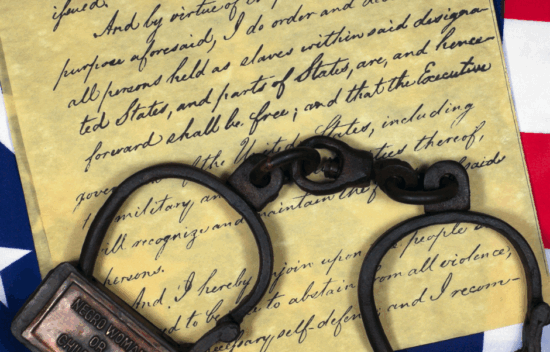
Views of Slavery Lesson Plan
Guiding Question
- How did slavery divide the nation?
Objectives
- Students will…
- Understand the range of views on slavery in the United States leading up to the Civil War.
- Analyze primary source quotes to identify perspectives supporting abolition or slavery.
- Represent historical perspectives on a spectrum to visualize the complexity of opinions.
Student Resources:
Teacher Resources:
- Large paper for spectrums: Chart paper, butcher paper, or bulletin board paper
- Glue
- Scissors
- Sticky notes
Facilitation Notes
- This lesson encourages students to think beyond binary perspectives and consider nuanced views, which is a challenging skill for this age group.
- It is important to acknowledge that slavery is morally wrong and fundamentally violates natural rights. Some of the perspectives presented in this lesson are historically accurate but deeply problematic. They are included not to legitimize or justify these views, but to understand the full scope of beliefs that shaped the nation’s history. This historical examination allows students to critically engage with the past and recognize the importance of natural rights and equality.
Anticipate
Glossary term(s): spectrum, abolition
Spectrum of Opinions
- Choose a current event (For example: War in Ukraine, Trade War with China, age restrictions on social media platforms).
Teacher note: Think the Vote has more debate topics and current events to consider. You could also use a less politically charged topic depending on the needs of your students.
- Draw a spectrum line on the board, labeled from Strongly Support to Strongly Oppose.
- Ask students to place their opinions on the spectrum with a sticky note and reflect on their placement:
- Why did you choose that spot?
- If you were in the middle, which side would you lean toward and why?
- Discuss: What is helpful about dichotomies? Why can they be limiting?
Engage
Reading on Views of Slavery
- Assign independent background reading of the Views of Slavery Essay.
Teacher note: The reading could be assigned for homework the night before. If your students benefit from more structured reading techniques, consider using one from our Modes of Reading Teacher Support Resource.
Explore
Matching Views to Primary Source quotes
- Transition: Arrange students in groups of 3-4. Distribute Views of Slavery Primary Source Set to student groups.
- Supply to each student group a set of primary sources and sorting labels. The labels are: In support of Abolition and In support of Slavery.
- Give students a time limit in which to read each primary source and sort it into one of the categories.
Assess & Reflect
Views of Slavery Spectrum
- Supply each group with chart paper and materials to create a spectrum.
- Students should glue the labels In Support of Abolition and In Support of Slavery on either end.
- Have students place the primary sources along the line to represent the range of views
AND/OR
Written Justification
- Ask students to choose 1-3 sources from the spectrum.
- Write a justification for their placement:
- If selecting three sources, they should represent a range (one from each end and one from the middle)
Extend (Optional)
- Add additional labels such as Mainline Republican, Southern Democrat, and Northern Democrat.
- Challenge students to align the primary sources with political views of the time.